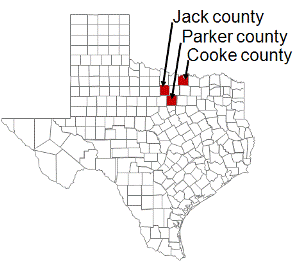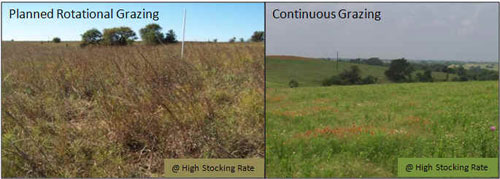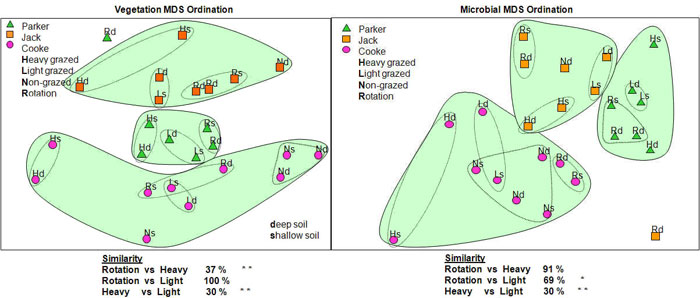 Funding Dixon Water Foundation
Funding Dixon Water Foundation
Project Duration January 2006 through December 2009
Research collaborators
Clint Josey, Robert Tuggle and Robert Potts, Dixon Water Foundation, Dallas
John and Brent Hackley, Richard’s Ranch, Jacksboro
Nathan Haile, Soil specialist, NRCS Weatherford, Texas
Jessica Jobe, Soil Scientist, NRCS Graham, Texas
The principle objectives of most livestock grazing systems are to maintain or improve forage production and forage harvesting efficiency. Maintenance or improvement of forage production is directly related to water infiltration rates. Therefore, the long-term success of a grazing system depends on how well increased livestock harvest efficiency, which reduces cover and biomass, is balanced with the need to maintain aggregate stability, which is improved by increased cover and soil organic matter.
A number of ranch properties in Texas and Oklahoma that use planned multi-paddock grazing management on native prairie are able to run many more animals and yet usually have more forage than their neighbors. It is also noticeable that their plant species composition, plant density and litter cover are usually superior to their neighbors. According to conventional wisdom, having range in better condition, having more grass and also having much higher stocking rates, are mutually exclusive. In addition, these multi-paddock managers cannot fill their stock tanks except with exceptionally intense rainstorms and have no visible signs of surface erosion. These observations appear to indicate that higher stocking rate and high stock density associated with many paddocks per herd on these ranches do not negatively impact soil physical and biological properties.
This project aims to assess the effect of multi-paddock grazing managed to achieve desirable vegetation and animal production goals relative to the two most common grazing practices, of light and moderate to heavy continuous grazing on the vegetation and soil chemical, physical, microbial and hydrological properties. We hypothesize that, at the ranch management scale, if multi-paddock grazing management is conducted to achieve high seral vegetation and moderate growing season defoliation levels there will be no negative effect on soil physical and hydrological properties or on vegetation composition and standing crop compared to season-long continuous grazing.
We conducted this study on three ranches that have been successfully practicing intensive planned rotational grazing for longer than 10 years and compared vegetation and soil parameters with adjacent ranches that have practiced continuous grazing at heavy or light rates for 10 or more years. These sites include the Richard’s Ranch in Jack County, the Pitman Ranch in Cook County and the Bear Creek Ranch, in Parker County.
Methods
Soil and plant parameters were measured on 3 ranches using multi-paddock grazing (HR at ± 10 ac/cow ) and compared to those of neighboring ranches that had been managed with continuous grazing using both light (LC at ± 20 ac/cow) and heavy (HC ± 10 ac/cow) stocking rates. The general practice on these ranches has been to graze a pasture at a light to moderate level in the growing season for 1 or 2 days followed by a recovery period of approximately 30 days during fast growing conditions and 60 days during slow growing conditions. This resulted in 2 light-to-moderate defoliations during the growing season with regrazing before the majority of plants switched from vegetative to reproductive phases. This kept the plants in a leafy condition to provide a high level of forage quality for the livestock and ensures the best possible regrowth after growing season defoliation. In the winter, the goal was to graze and trample most of the standing forage to minimize self-shading in spring that would limit plant growth. Livestock numbers are adjusted in times of drought to ensure the vegetation is not grazed too heavily. Sampling was conducted on two soil series in each case. Sample sites were approximately 300 m from watering points.
Soil microbes are important regulators of soil physical parameters influencing rainfall infiltration and the growth regulation of plants. Little research has been done in this environment detailing the response of soil microbes to fire, grazing and no disturbance. We have monitored soil microbe populations to gain an insight into how soil microbes respond to these disturbances and determine how they influence prairie plants.
Measurements
1. Plant biomass and species composition;
2. Bare ground and litter cover
3. Soil infiltration: hydraulic conductivity and double-ring infiltration
4. Aggregate stability, penetration resistance, and soil bulk density;
5. Soil pH, cation exchange capacity (CEC), carbon to nitrogen ratio; and
6. Soil microbial community including: total bacteria and fungi, active bacteria and fungi, protozoa, nematodes and VAM: mycorrhizal colonization.
Results and Discussion
The objective of ranchers using light continuous grazing (LC) is to maintain dominance of the more productive high seral grasses using low levels of herbage utilization. Managers who use high levels of utilization with higher stocking rates and continuous grazing (HC) aim at a higher level of herbage utilization and harvest efficiency. The ranchers in this study using rotational grazing managed for optimizing herbage utilization (heavy stocking rates according to NRCS guidelines) while maintaining high seral plant species by moderate use and strategic and timely rotational grazing (HR). These 3 different methods of grazing resulted in a number of different vegetation and soils responses.
Vegetation composition and cover
As hypothesized, vegetation composition on the rotationally grazed areas was as good as that on the light continuously grazed areas and better than that on the heavy continuously grazed areas. Tall grass biomass was much lower and cool season grasses and annual forbs were much greater on the HC than with the HR or LC areas. Regarding vegetation cover, the amount of bare ground was much higher on the HC than both HR and LC management areas.
Soil properties
Soil bulk density, aggregate stability and infiltration rate were not different between the different grazing management areas but penetration resistance, a measure of soil compaction, was higher on the HC than both the LC and HR areas. These results are similar to those reported for the Sonora research Station, Texas. The composition of soil microbes with LC was similar to that of grazing exclosures while that of RC and HC were similar. We postulate that this is a result of the higher levels of herbage utilization with the heavily stocked areas resulting in a higher rate of nutrient cycling than on the lightly- grazed and non-grazed areas.
Conclusions
While research findings often suggest multi-paddock grazing management is not superior to continuous grazing, researchers have not managed trials to answer practical questions such as: how good is this management option, where is it successful, and what does it take to make it work as well as possible? In contrast, successful ranchers manage strategically to achieve the best possible profitability and ecosystem health and the benefits of multi-paddock rotational grazing on commercial livestock enterprises have been evident for many years in many countries.
In this study we examined neighboring ranches to compare the impact of rotational grazing as practiced by managers who achieved excellent livestock and vegetation results with areas grazed continuously at either light or heavy stocking rates. The rotational grazing managers have achieved high levels of animal performance per acre while equaling the vegetation composition, soil cover and soil health measured on ranches under light continuous grazing. We postulate that the differences in soil microbial populations we measured indicate higher levels of nutrient turnover in the more heavily grazed areas.
Teague, W.R., Dowhower, S.L., Baker, S.A., Haile, N., DeLaune, P.B., Conover, D.M., 2011. Grazing management impacts on vegtetation, soil biota and soil chemical, physical and hydrological properties in tall grass prairie. Agriculture Ecosystems and Environment 141, 310-322.

